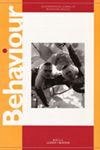A review of the behaviours of the Chondrichthyes: a multi-species ethogram for the chimaeras, sharks, and rays
IF 1
4区 生物学
Q4 BEHAVIORAL SCIENCES
引用次数: 2
Abstract
In this review of the behavioural patterns of chondrichthyan fishes, we have strived to produce a comprehensive catalogue of events and states and develop standardized terminology. Hence, actions that are slightly different, will be pooled under inclusive titles. Those used by different investigators are included in quotations within the textual descriptions of the motor patterns. This standardized ethogram will ideally lead to an increase in inter-observer reliability, giving researchers more confidence when reading colleagues’ papers that report behaviours that appear similar to theirs despite being described for different species. The descriptions are presented under the following categories: (1) maintenance (2) courtship (3) filter feeding (4) scavenging (5) predation (6) sociality (7) aggression and (8) defence. The many actions are illustrated by line drawings and photographs in composite figures with an attempt to provide an example of each action for a chimaera, shark, and ray. The diversity of patterns is evident from this ethogram, consistent with observation that the brain-to-body mass ratios of cartilaginous fishes are greater than a third of the bird species and greater than those for some mammalian species. The major impetus for assembling this ethogram is to demonstrate the diversity of behaviours exhibited by members of the Chondrichthyes and to dispel the apocryphal belief that members of this taxon are ‘simple feeding machines’.软骨鱼类行为的综述:嵌合体、鲨鱼和鳐鱼的多物种谱系图
在这篇关于软骨鱼行为模式的综述中,我们努力制作一个事件和状态的综合目录,并开发标准化术语。因此,略有不同的操作将被合并到包含标题下。由不同研究者使用的那些包含在运动模式文本描述中的引文中。理想情况下,这种标准化的谱图将增加观察者之间的可靠性,使研究人员在阅读同事的论文时更有信心,这些论文报告的行为与他们的相似,尽管描述的是不同的物种。描述可分为以下几类:(1)维持(2)求偶(3)滤食(4)食腐(5)捕食(6)群居(7)攻击(8)防御。许多动作都是通过线条图和合成图的照片来说明的,试图为chimaera, shark和ray提供每个动作的例子。从这幅谱图中可以明显看出模式的多样性,这与观察结果相一致,即软骨鱼的脑与身体的质量比大于鸟类的三分之一,并且大于某些哺乳动物物种。收集这张族谱的主要动机是为了证明软骨鱼目成员表现出的行为多样性,并消除这种分类单元成员是“简单的进食机器”的虚假信念。
本文章由计算机程序翻译,如有差异,请以英文原文为准。
求助全文
约1分钟内获得全文
求助全文
来源期刊

Behaviour
生物-动物学
CiteScore
1.80
自引率
7.70%
发文量
44
审稿时长
3 months
期刊介绍:
Behaviour is interested in all aspects of animal (including human) behaviour, from ecology and physiology to learning, cognition, and neuroscience. Evolutionary approaches, which concern themselves with the advantages of behaviour or capacities for the organism and its reproduction, receive much attention both at a theoretical level and as it relates to specific behavior.
 求助内容:
求助内容: 应助结果提醒方式:
应助结果提醒方式:


